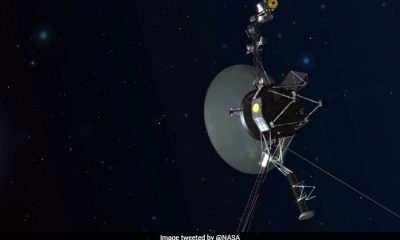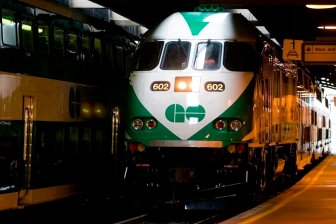Business
JPMorgan Chase to buy distressed First Republic Bank in deal brokered by U.S. regulator
|
|


Regulators seized troubled First Republic Bank early Monday and sold all of its deposits and most of its assets to JPMorgan Chase Bank in a bid to head off further banking turmoil in the U.S. San Francisco-based First Republic is the third midsize bank to fail in two months.
San Francisco-based First Republic is the third midsize bank to fail in two months. It is the second-biggest bank failure in U.S. history, behind only Washington Mutual, which collapsed at the height of the 2008 financial crisis and was also taken over by JPMorgan.
First Republic has struggled since the collapse of Silicon Valley Bank and Signature Bank and investors and depositors had grown increasingly worried it might not survive because of its high amount of uninsured deposits and exposure to low interest rate loans.
The Federal Deposit Insurance Corporation (FDIC) said early Monday that First Republic Bank’s 84 branches in eight states will reopen as branches of JPMorgan Chase Bank and depositors will have full access to all of their deposits.
Regulators worked through the weekend to find a way forward before U.S. stock markets opened. Markets in many parts of the world were closed for May 1 holidays Monday. The two markets in Asia that were open, in Tokyo and Sydney, rose.
“Our government invited us and others to step up, and we did,” said Jamie Dimon, chairman and CEO of JPMorgan Chase.
As of April 13, First Republic had approximately $229 billion US in total assets and $104 billion in total deposits, the FDIC said. The FDIC estimated its deposit insurance fund would take a $13 billion hit from taking First Republic into receivership. Its rescue of Silicon Valley Bank cost the fund a record $20 billion.
At the end of last year, the Federal Reserve ranked it 14th in size among U.S. commercial banks.
Growth undercut by ininsured deposits
Before Silicon Valley Bank failed, First Republic had a banking franchise that was the envy of most of the industry. Its clients — mostly the rich and powerful — rarely defaulted on their loans. The bank has made much of its money making low-cost loans to the wealthy, which reportedly included Meta Platforms CEO Mark Zuckerberg.
Flush with deposits from the well-heeled, First Republic saw total assets more than double from $102 billion at the end of 2019’s first quarter, when its full-time workforce was 4,600.
But the vast majority of its deposits, like those in Silicon Valley and Signature Bank, were uninsured — that is, above the $250,000 limit set by the FDIC. And that worried analysts and investors. If First Republic were to fail, its depositors might not get all their money back.
Those fears were crystallized in the bank’s recent quarterly results. The bank said depositors pulled more than $100 billion out of the bank during April’s crisis. San Francisco-based First Republic said that it was only able to stanch the bleeding after a group of large banks stepped in to save it with $30 billion in uninsured deposits.
Since the crisis, First Republic has been looking for a way to quickly turn itself around. The bank planned to sell off unprofitable assets, including the low-interest mortgages that it provided to wealthy clients. It also announced plans to lay off up to a quarter of its workforce, which totalled about 7,200 employees in late 2022.
To protect depositors, we entered into an agreement with JP Morgan Chase Bank to purchase and assume all deposits and assets of First Republic Bank. Read more ➡️ <a href=”https://t.co/8KCKgJ2ZWR”>https://t.co/8KCKgJ2ZWR</a>. <a href=”https://t.co/FRrIZk5aBY”>pic.twitter.com/FRrIZk5aBY</a>
—@FDICgov
Investors remained skeptical. The bank’s executives have taken no questions from investors or analysts since the bank reported its results, causing First Republic’s stock to sink further.
It can be hard to profitably restructure a balance sheet when a firm has to sell off assets quickly and has fewer bankers to find opportunities for the bank to invest in. It took years for banks like Citigroup and Bank of America to return to profitability after the global financial crisis 15 years ago, and those banks had the benefit of a government-aided backstop to keep them going.





Business
Gildan replacing five directors ahead of AGM, will back two Browning West nominees
|
|
MONTREAL — Gildan Activewear Inc. is making changes to its board of directors in an attempt to head off a move by an activist shareholder looking to replace a majority of the board at its annual meeting next month.
U.S. investment firm Browning West wants to replace eight of Gildan’s 12 directors with its own nominees in a move to bring back founder Glenn Chamandy as chief executive.
Gildan, which announced late last year that Chamandy would be replaced by Vince Tyra, said Monday it will replace five members of its board of directors ahead of its annual meeting set for May 28.
It also says current board members Luc Jobin and Chris Shackelton will not run for re-election and that it will recommend shareholders vote for Karen Stuckey and J.P. Towner, who are two of Browning West’s eight nominees.
The new directors who will join the Gildan board on May 1 are Tim Hodgson, Lee Bird, Jane Craighead, Lynn Loewen and Les Viner. They will replace Donald Berg, Maryse Bertrand, Shirley Cunningham, Charles Herington and Craig Leavitt.
Hodgson, who served as chief executive of Goldman Sachs Canada from 2005 to 2010, is expected to replace Berg as chair.
“I look forward to working with this highly qualified board and management team to realize the full benefits of Vince’s ambitious yet realistic plan to drive growth by enhancing the Gildan sustainable growth strategy,” Hodgson said in a statement.
“The refreshed board and I fully believe in Vince and his talented team as well as Gildan’s leading market position and growth prospects.”
Gildan has been embroiled in controversy ever since it announced Chamandy was being replaced by Tyra.
The company has said Chamandy had no credible long-term strategy and had lost the board’s confidence. But several of Gildan’s investors have criticized the company for the move and called for his return.
Those investors include the company’s largest shareholder, Jarislowsky Fraser, as well as Browning West and Turtle Creek Asset Management.
In announcing the board changes, Gildan said it met with shareholders including those who Browning West has counted as supportive.
“Our slate strikes a balance between ensuring the board retains historical continuity during a period of transition and provides fresh perspectives to ensure it continues to serve its important oversight function on behalf of all shareholders,” the company said.
Gildan said last month that it has formed a special committee of independent directors to consider a “non-binding expression of interest” from an unnamed potential purchaser and contact other potential bidders.
But Browning West and Turtle Creek have said the current board cannot be trusted to oversee a sale of the company.
The company said Monday that there continues to be external interest in acquiring the company and the process is ongoing.
This report by The Canadian Press was first published April 22, 2024.
Companies in this story: (TSX:GIL)
The Canadian Press





Business
Ottawa puts up $50M in federal budget to hedge against job-stealing AI – CP24


Anja Karadeglija, The Canadian Press
Published Sunday, April 21, 2024 4:02PM EDT
Last Updated Sunday, April 21, 2024 4:04PM EDT
Worried artificial intelligence is coming for your job? So is the federal government — enough, at least, to set aside $50 million for skills retraining for workers.
One of the centrepiece promises in the federal budget released Tuesday was $2.3 billion in investments aiming to boost adoption of the technology and the artificial intelligence industry in Canada.
But tucked alongside that was a promise to invest $50 million over four years “to support workers who may be impacted by AI.” Workers in “potentially disrupted sectors and communities” will receive new skills training through the Sectoral Workforce Solutions Program.
“There is a significant transformation of the economy and society on the horizon around artificial intelligence,” said Joel Blit, an associate professor of economics at the University of Waterloo.
Some jobs will be lost, others will be created, “but there’s going to be a transition period that could be somewhat chaotic.”
While jokes about robots coming to take jobs predate the emergence of generative AI systems in late 2022, the widespread availability of systems like ChatGPT made those fears real for many, even as workers across industries began integrating the technology into their workday.
In June 2023, a briefing note for Finance Minister Chrystia Freeland warned the impact of generative AI “will be felt across all industries and around 40 per cent of all working hours could be impacted.”
“Banking, insurance and energy appear to have higher potential for automation compared to other sectors,” says the note, obtained through access to information and citing information from Accenture.
“This could have substantial impacts on jobs and skills requirements.”
The budget only singles out “creative industries” as an affected sector that will be covered by the program. In February, the Canadian TV, film, and music industries asked MPs for protection against AI, saying the tech threatens their livelihood and reputations.
Finance Canada did not respond to questions asking what other sectors or types of jobs would be covered under the program.
“The creative industries was used as an illustrative example, and not intended as an exclusion of other affected areas,” deputy Finance spokesperson Caroline Thériault said in a statement.
In an interview earlier this year, Bea Bruske, president of the Canadian Labour Congress, said unions representing actors and directors have been very worried about how their likenesses or their work could be used by AI systems. But the “reality is that we have to look at the implication of AI in all jobs,” she said.
Blit explained large language models and other generative AI can write, come up with new ideas and then test those ideas, analyze data, as well as generate computer programming code, music, images, and video.
Those set to be affected are individuals in white-collar professions, like people working in marketing, health care, law and accounting.
In the longer run, “it’s actually quite hard to predict who is going to be impacted,” he said. “What’s going to happen is that entire industries, entire processes are going to be reimagined around this new technology.”
AI is an issue “across sectors, but certainly clerical and customer service jobs are more vulnerable,” Hugh Pouliot, a spokesperson for the Canadian Union of Public Employees, said in an email.
The federal government has used AI in nearly 300 projects and initiatives, new research published earlier this month revealed.
According to Viet Vu, manager of economic research at Toronto Metropolitan University’s the Dais, the impact of AI on workers in a sector like the creative industry doesn’t have to be negative.
“That’s only the case if you adopt it irresponsibly,” he said, pointing out creative professionals have been adopting new digital tools in their work for years.
He noted only four per cent of Canadian businesses are using any kind of artificial intelligence or machine learning. “And so we’re really not there yet for these frontier models and frontier technologies” to be making an impact.
When it comes to the question of how AI will affect the labour market, it’s more useful to think about what types of tasks technology can do better, as opposed to whether it will replace entire jobs, Vu said.
“A job is composed of so many different tasks that sometimes even if a new technology comes along and 20, 30 per cent of your job can be done using AI, you still have that 60, 70 per cent left,” he said.
“So it’s rare that (an) entire occupation is actually sort of erased out of existence because of technology.”
Finance Canada also did not respond to questions about what new skills the workers would be learning.
Vu said there are two types of skills it makes sense to focus on in retraining — computational thinking, or understanding how computers operate and make decisions, and skills dealing with data.
There is no AI system in the world that does not use data, he said. “And so being able to actually understand how data is curated, how data is used, even some basic data analytics skills, will go a really long way.”
But given the scope of the change the AI technology is set to trigger, critics say a lot more than $50 million will be necessary.
Blit said the money is a good first step but won’t be “close to enough” when it comes to the scale of the coming transformation, which will be comparable to globalization or the adoption of computers.
Valerio De Stefano, Canada research chair in innovation law and society at York University, agreed more resources will be necessary.
“Jobs may be reduced to an extent that reskilling may be insufficient,” and the government should look at “forms of unconditional income support such as basic income,” he said.
The government should also consider demanding AI companies “contribute directly to pay for any social initiative that takes care of people who lose their jobs to technology” and asking “employers who reduce payrolls and increase profits thanks to AI to do the same.”
“Otherwise, society will end up subsidizing tech businesses and other companies as they increase profit without giving back enough for technology to benefit us all.”
Business
Honda to build electric vehicles and battery plant in Ontario, sources say – Global News
Honda Canada is set to build an electric vehicle battery plant near its auto manufacturing facility in Alliston, Ont., where it also plans to produce fully electric vehicles, The Canadian Press has learned.
Senior sources with information on the project confirmed the federal and Ontario governments will make the announcement this week, but were not yet able to give any dollar figures.
However, comments Monday from Ontario Premier Doug Ford and Economic Development Minister Vic Fedeli suggest it is a project worth around $14 billion or $15 billion.
Ford told a First Nations conference that there will be an announcement this week about a new deal he said will be double the size of a Volkswagen deal announced last year. That EV battery plant set to be built in St. Thomas, Ont., comes with a $7-billion capital price tag.
Fedeli would not confirm if Ford was referencing Honda, but spoke coyly after question period Monday about the amount of electric vehicle investment in the province.
“We went from zero to $28 billion in three years and if the premier, if his comments are correct, then next week, we’ll be announcing $43 billion … in and around there,” he said.
More on Canada
The Honda facility will be the third electric vehicle battery plant in Ontario, following in the footsteps of Volkswagen and a Stellantis LG plant in Windsor, and while those two deals involved billions of dollars in production subsidies as a way of competing with the United States’ Inflation Reduction Act subsidies, Honda’s is expected to involve capital commitments and tax credits.
Federal Finance Minister Chrystia Freeland’s recent budget announced a 10-per-cent Electric Vehicle Supply Chain investment tax credit on the cost of buildings related to EV production as long as the business invests in assembly, battery production and cathode active material production in Canada.
That’s on top of an existing 30-per-cent Clean Technology Manufacturing investment tax credit on the cost of investments in new machinery and equipment.
Honda’s deal also involves two key parts suppliers for their batteries — cathodes and separators — with the locations of those facilities elsewhere in Ontario set to be announced at a later date.
The deal comes after years of meetings and discussions between Honda executives and the Ontario government, the sources said.
Prime Minister Justin Trudeau, Premier Doug Ford and Honda executives were on hand in March 2022 in Alliston when the Japanese automaker announced hybrid production at the facility, with $131.6 million in assistance from each of the two levels of government.
Around the time of that announcement, conversations began about a larger potential investment into electric vehicles, the sources said, and negotiations began that summer.
Fedeli travelled to Japan that fall, the first of three visits to meet with Honda Motor executives about the project. Senior officials from the company in Japan also travelled to Toronto three times to meet with government officials, including twice with Ford.
During a trip by the Honda executives to Toronto in March 2023, Ontario officials including Fedeli pitched the province as a prime destination for electric vehicle and battery investments, part of a strong push from the government to make Ford’s vision of an end-to-end electric vehicle supply chain in the province a reality.
Negotiations took a major step forward that July, when Ontario sent a formal letter to Honda Canada, signalling its willingness to offer incentives for a battery plant and EV production. Honda Canada executives then met with Ford in November and December.
The latter meeting sealed the deal, the sources said.
Honda approached the federal government a few months ago, a senior government official said, and Freeland led her government’s negotiations with the company.
The project is expected to involve the construction of several plants, according to the source.
— With files from Nojoud Al Mallees in Ottawa.
© 2024 The Canadian Press
-



 Health8 hours ago
Health8 hours agoRemnants of bird flu virus found in pasteurized milk, FDA says
-
Art14 hours ago
Mayor's youth advisory council seeks submissions for art gala – SooToday
-



 Science22 hours ago
Science22 hours ago"Hi, It's Me": NASA's Voyager 1 Phones Home From 15 Billion Miles Away – NDTV
-
News20 hours ago
Some Canadians will be digging out of 25+ cm of snow by Friday – The Weather Network
-



 Health12 hours ago
Health12 hours agoBird flu virus found in grocery milk as officials say supply still safe
-
Media19 hours ago
Jon Stewart Slams the Media for Coverage of Trump Trial – The New York Times
-



 Investment13 hours ago
Investment13 hours agoTaxes should not wag the tail of the investment dog, but that’s what Trudeau wants
-



 Sports23 hours ago
Sports23 hours agoAuston Matthews turns it up with three-point night as Maple Leafs slay Bruins in Game 2 – Toronto Sun






